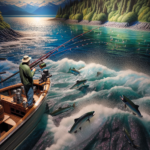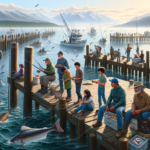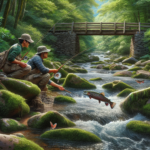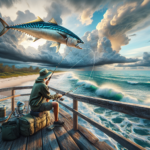Shore Fishing for Flounder in New Jersey’s Coastal Waters

Introduction
Did you know that New Jersey’s coastal waters are home to some of the best shore fishing opportunities for flounder on the East Coast? Whether you’re a seasoned angler or a novice looking to try your hand at fishing, shore fishing for flounder in New Jersey offers an exciting and rewarding experience. This article will cover everything you need to know about shore fishing for flounder in New Jersey, from the best techniques and gear to the top fishing spots and seasonal considerations.
Why does this matter? For many, fishing is more than just a hobby; it’s a way to connect with nature, relax, and even provide food for the table. Understanding the best practices and locations for shore fishing flounder can significantly enhance your fishing experience and increase your chances of a successful catch.
Background/Context
Historical or Cultural Significance
Flounder fishing has a long history in New Jersey, dating back to the early settlers who relied on the abundant coastal waters for sustenance. Over the years, it has evolved into a popular recreational activity, drawing anglers from all over the region. The flounder, also known as fluke, is a prized catch due to its delicious taste and the challenge it presents to anglers.
Geographical Overview
New Jersey’s coastline stretches for 130 miles, offering a diverse range of fishing environments, from sandy beaches and rocky jetties to estuaries and bays. The state’s coastal waters are influenced by the Atlantic Ocean, providing a rich and varied ecosystem that supports a wide range of marine life, including flounder. The climate is generally temperate, with warm summers and mild winters, making it an ideal location for year-round fishing.
Key Points/Details
Fishing Techniques
Technique Overview
When it comes to shore fishing for flounder, several techniques can be effective. The most common methods include bottom fishing, drift fishing, and jigging. Bottom fishing involves casting your baited hook to the ocean floor, where flounder are known to dwell. Drift fishing allows your bait to move naturally with the current, covering more ground. Jigging involves using a weighted lure that mimics the movement of prey, enticing flounder to strike.
When and Where to Use
Bottom fishing is particularly effective in areas with sandy or muddy bottoms, such as beaches and estuaries. Drift fishing works well in areas with strong currents, like inlets and channels. Jigging can be used in various locations but is especially effective around structures like jetties and piers where flounder may be hiding.
Recommended Gear
- Rods: Medium to heavy-action rods, around 6-7 feet in length.
- Reels: Spinning reels with a good drag system.
- Lines: Braided line (20-30 lb test) for sensitivity and strength.
- Bait: Live bait such as minnows, squid, or shrimp; artificial lures like bucktail jigs.
Species Information
Species Overview
The flounder, or fluke, is a flatfish known for its distinctive appearance and behavior. They have both eyes on one side of their body and are masters of camouflage, often burying themselves in the sand to ambush prey. Flounder prefer shallow coastal waters with sandy or muddy bottoms and are most active during the warmer months.
Best Practices
To successfully catch flounder, it’s essential to use the right bait and techniques. Live bait such as minnows or squid is highly effective, as is using a slow, steady retrieve to mimic the movement of prey. Pay attention to the tides, as flounder are more active during incoming and outgoing tides. Early morning and late afternoon are generally the best times to fish for flounder.
Location Information
Top Fishing Spots
- Sandy Hook: Offers excellent shore fishing opportunities with easy access and amenities.
- Island Beach State Park: Known for its productive surf fishing and beautiful scenery.
- Barnegat Bay: A prime location for flounder fishing, especially around the inlets and channels.
- Great Bay: Offers a variety of fishing environments, from marshes to open water.
Regulations and Licenses
Before heading out, make sure to familiarize yourself with New Jersey’s fishing regulations. A valid fishing license is required for anglers aged 16 and older. There are also specific size and bag limits for flounder, which can vary by season. Always check the latest regulations from the New Jersey Division of Fish and Wildlife to ensure compliance.
Seasonal Considerations
Seasonal Variations
Flounder fishing in New Jersey is highly seasonal, with the best fishing occurring from late spring to early fall. During the warmer months, flounder move into shallower waters to feed, making them more accessible to shore anglers. In the winter, they migrate to deeper offshore waters.
Best Times to Fish
The optimal time for shore fishing flounder is from May to September, with peak activity typically occurring in June and July. Early morning and late afternoon are the best times of day to fish, as flounder are more active during these periods.
Events and Tournaments
Event Overview
New Jersey hosts several fishing tournaments and events throughout the year, many of which include categories for flounder. These events offer a great opportunity to test your skills, meet fellow anglers, and potentially win prizes.
Preparation Tips
- Gear: Ensure your gear is in top condition and suited for the event’s specific requirements.
- Practice: Spend time practicing your techniques and scouting potential fishing spots.
- Strategy: Develop a game plan based on the event’s rules and the local fishing conditions.
Tips and Best Practices
General Tips
- Always check the weather forecast before heading out.
- Use a fish finder or local fishing reports to locate productive areas.
- Be patient and persistent; flounder can be elusive but are worth the effort.
Avoid Common Mistakes
- Using the wrong bait or lures: Stick to proven options like live minnows or bucktail jigs.
- Fishing at the wrong time: Focus on early morning or late afternoon during peak seasons.
- Ignoring the tides: Flounder are more active during tidal changes, so plan your trips accordingly.
Advanced Techniques
- Try using a Carolina rig to present your bait more naturally on the ocean floor.
- Experiment with different retrieval speeds and patterns to find what works best.
- Use scented baits or attractants to increase your chances of a strike.
Gear and Equipment Recommendations
Essential Gear
- Medium to heavy-action rod (6-7 feet)
- Spinning reel with a good drag system
- Braided line (20-30 lb test)
- Live bait (minnows, squid) or artificial lures (bucktail jigs)
Optional Gear/Upgrades
- Fish finder or depth sounder
- Waders for fishing in shallow waters
- Tackle box with a variety of hooks, weights, and lures
Where to Buy or Rent
Local bait and tackle shops in New Jersey offer a wide range of gear and equipment for shore fishing. Some popular options include:
- Fisherman’s Headquarters in Ship Bottom
- Grumpy’s Bait and Tackle in Seaside Park
- Jersey Hooker Outfitters in Brick
Safety and Conservation
Safety Tips
- Always wear a life jacket when fishing near water.
- Be aware of your surroundings and watch for changing weather conditions.
- Use sunscreen and stay hydrated, especially during the summer months.
Conservation Practices
- Practice catch and release to help sustain flounder populations.
- Follow all local fishing regulations and size/bag limits.
- Dispose of fishing line and other waste properly to protect the environment.
Planning Your Trip
Accommodations
There are plenty of accommodation options near New Jersey’s top fishing spots, ranging from hotels and motels to campgrounds and vacation rentals. Some popular choices include:
- Sandy Hook: Gateway National Recreation Area offers camping facilities.
- Island Beach State Park: Nearby hotels in Seaside Park and Toms River.
- Barnegat Bay: Various vacation rentals and hotels in the Barnegat Light area.
Travel Tips
- Plan your route in advance and check for any road closures or construction.
- Consider carpooling with fellow anglers to save on travel costs.
- Bring a map or GPS device to help navigate to your fishing spot.
Additional Activities
If you’re traveling with family or friends who aren’t into fishing, there are plenty of other activities to enjoy in New Jersey’s coastal areas. These include:
- Beachcombing and swimming
- Hiking and birdwatching in local parks and nature reserves
- Exploring nearby towns and enjoying local cuisine
Frequently Asked Questions (FAQs)
What is the best time of year to fish for flounder in New Jersey?
The best time to fish for flounder in New Jersey is from late spring to early fall, with peak activity typically occurring in June and July.
Do I need a fishing license to fish for flounder in New Jersey?
Yes, a valid fishing license is required for anglers aged 16 and older. Make sure to check the latest regulations from the New Jersey Division of Fish and Wildlife.
What bait is best for catching flounder?
Live bait such as minnows, squid, or shrimp is highly effective for catching flounder. Artificial lures like bucktail jigs can also be successful.
Where are the best shore fishing spots for flounder in New Jersey?
Some of the top shore fishing spots for flounder in New Jersey include Sandy Hook, Island Beach State Park, Barnegat Bay, and Great Bay.
Conclusion
Shore fishing for flounder in New Jersey’s coastal waters offers an exciting and rewarding experience for anglers of all skill levels. By understanding the best techniques, gear, and locations, you can significantly enhance your chances of a successful catch. Remember to follow local regulations, practice conservation, and prioritize safety to ensure a positive and sustainable fishing experience. So grab your gear, head to the shore, and enjoy the thrill of flounder fishing in New Jersey!




